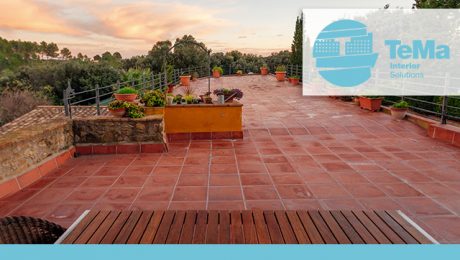Protecting outdoor flooring with drainage geocomposites
Autumn precipitation, winter frosts and scorching summer heat may even be followed by a downpour lasting a few minutes. Terraces and balconies, or outdoor flooring in general, are affected by seasonal and sometimes daily weather events and temperature fluctuations that put the resistance of flooring at risk.
So how can we protect them?
Drainage geocomposites are the solution, but let’s take a closer look at them and their functions.
What are drainage geocomposites and when should they be used?
They are geosynthetic materials with a drainage core bonded to a non-woven filtering fabric. They can be used on walls, underground structures, flat roofs, trafficable roofs, flat green roofs, as well as terraces, balconies and outdoor flooring.
TeMa Interior Solutions suggestsT-K NW and T-K Net, polyethylene studded membranes bonded to a non-woven fabric that acts as a filtering layer for T-K NW or a HDPE mesh for T-K Net.
What are the functions?
The functions of geosynthetic products are set out in the UNI EN ISO 10318 standard.
![]()
Drainage
As the name implies, the main function of geosynthetic products is to drain any water that may seep into the screed. Passive capillary drainage eliminates the risk of stagnant water in the system and, if there are rooms below, prevents moisture from damaging the insulating layer.
![]()
Protecting the waterproofing layer
Damage to the waterproofing layer causes significant and immediately visible problems. Moisture and water penetrating into deeper layers, compromise the durability and strength of the structure, causing cracks in tiles. Protection is therefore necessary.
![]()
Distributing the load
Flooring often has to withstand heavy loads, such as outdoor tables, sunshades, large plant pots etc…. Using studded membranes, which are highly resistant to loads, allows the screed to remain “suspended” from the sealing layer (i.e. the waterproofing layer) below, protecting it from perforations and abrasions.
Advantages of applying the system
The time required is extremely short and flooring can be laid after a few days.
The thickness of the membranes is much reduced, an advantage not to be underestimated in renovations. Moreover, the thresholds of French windows opening outwards or onto a terrace do not need to be raised.
Lastly, in consideration of the environment, the materials are safe and odourless. They do not develop toxic gases or organic components, and comply with VOC standards. No hazardous substances are released underground.
- Published in Balconies and terraces, INTERIOR, Levelling, or structural, waterproofing panels, Waterproofing system with membranes, Waterproofing with panels


